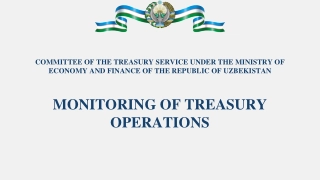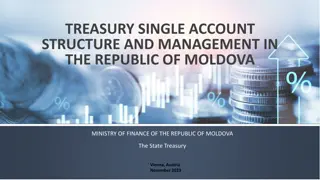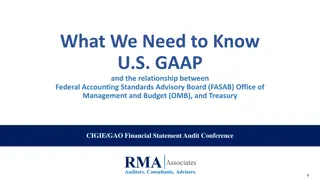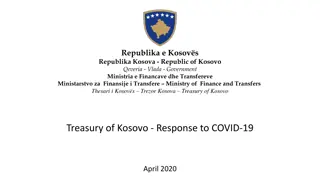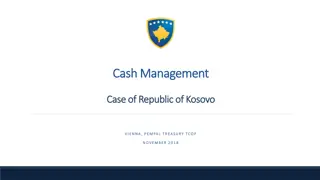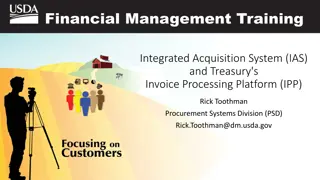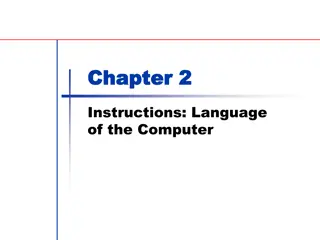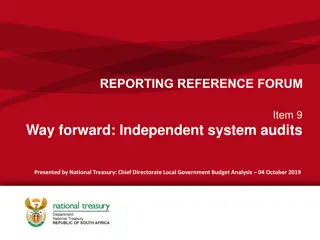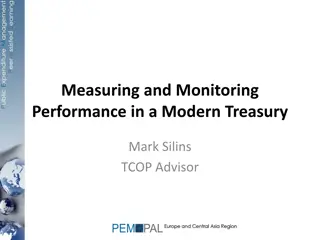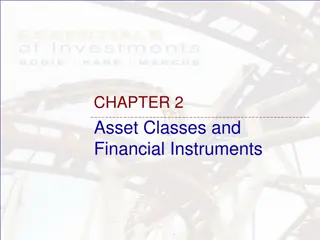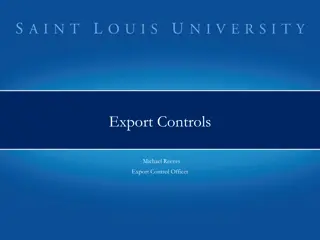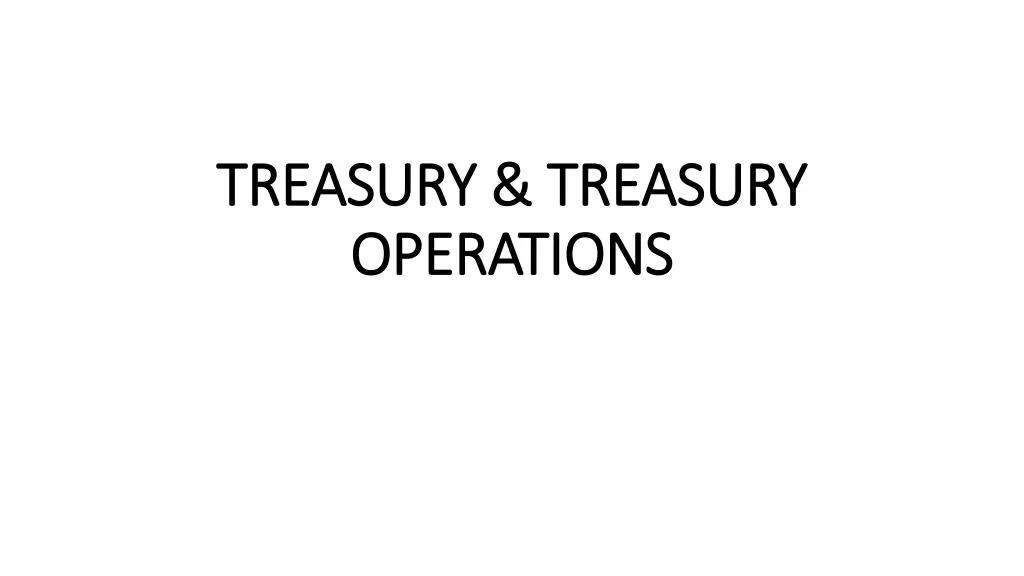
Understanding Roles and Departments in Bank Treasuries
Explore the roles of dealers in securities trading, different types of dealers, the front office's responsibilities, and the various departments within bank treasuries, from fixed income to proprietary trading, all crucial for efficient treasury operations.
Download Presentation

Please find below an Image/Link to download the presentation.
The content on the website is provided AS IS for your information and personal use only. It may not be sold, licensed, or shared on other websites without obtaining consent from the author. If you encounter any issues during the download, it is possible that the publisher has removed the file from their server.
You are allowed to download the files provided on this website for personal or commercial use, subject to the condition that they are used lawfully. All files are the property of their respective owners.
The content on the website is provided AS IS for your information and personal use only. It may not be sold, licensed, or shared on other websites without obtaining consent from the author.
E N D
Presentation Transcript
TREASURY & TREASURY TREASURY & TREASURY OPERATIONS OPERATIONS
Treasury Structures http://1.bp.blogspot.com/-iFsJ9eCUTu0/TaMAqpDbOKI/AAAAAAAAAK8/L_FHUpTxauQ/s400/Treasury.jpg
ROLE OF DEALER and selling securities for their own account, whether through a broker or otherwise. A person or firm in the business of buying A dealer is defined by the fact that it acts as principal in trading for its own account, as opposed to a broker who acts as an agent in executing orders on behalf of its clients.
ROLE OF DEALER Cntd. Dealers, buy and sell securities for their own accounts, adding liquidity to the market place and seeking to profit from the spread between the prices at which they buy and sell. In the over-the-counter market, in most cases, it is dealers -- also called market makers -- who provide the bid and askquotes you see when you look up the price of a security.
DIFFERENT TYPES OF DEALERS Proprietary Dealer-these are dealer that buy and sell on behalf of the bank-Interbank dealer Sales or Client Dealer- they act on behalf of their client, they are in between client and prop dealer Branch Dealer-act as liaison between the trading room and the bank s branch
Front Office The Front Office is mainly responsible for managing Assets and Liabilities of the bank, it includes activities like trading in bonds, currencies, financial derivatives and also encompasses the associated financial risk management.
Bank Treasuries may have the following departments: Fixed Income or Money Market desk that is devoted to buying and selling interest bearing securities. Foreign exchange or "FX" desk that buys and sells currencies Capital Markets or Equities desk that deals in shares listed on the stock market. Derivative Market desk that deals in interest rate and structure derivative products Asset liability management or ALM desk that manages the risk of interest rate mismatch and liquidity Proprietary Trading desk that conducts trading activities for the bank's own account
Back/Mid Office The Back/Mid Office is responsible for Accounting, Valuations, Market Risk, Processing, Settling, Confirming and Reconciling the transactions completed in the Front-Office.
Process overview Treasury is dynamic field and the current trend in treasury operations is to have professionals dedicated to specific areas-specialists than generalists e.g. FX desk will have their back office team and so on. Front office is responsible for initiation and completion of deal. Middle office are responsible for risk management function and compliance (limits, approved policies and procedures etc).
Core Functions of Back Office There are three core functions of the back office; Deal confirmation Settlement of the deal Reconciliation of Nostro accounts, position etc. Process for deal completion is similar irrespective of the instrument or market in which it is being dealt
Input (STP)- Confirmation-Settlement Reconciliation Standard Settlement Instruction SSI- Settlement should be actioned using SSI, these allow more efficient and controlled process in settling trades, it mitigates any potential settlement risk and fraud. Special attention must be given to third party payments Cut off time for good value must be adhered to in order to avoid unnecessary default and interest rate claims.
Segregation of Duties One of the key strategies used to reduce the risk of error or fraud is the segregation of duties. However, smaller treasuries often struggle to apply this in practice. We will discuss the key stages that should be followed in order to segregate treasury duties, the obstacles that many treasuries encounter and the measures that can be taken to overcome them
Why segregate treasury duties? The segregation of duties is a fundamental technique used to manage personnel risk, ie the risk that action or inaction by a member of staff may lead to significant loss. The most likely cause of loss is simple error, whether this is due to carelessness or inexperience. This risk may be at its greatest when a new member of staff is taken on who may be less experienced than their predecessor yet given the same level of authorisation. There is also a risk that individuals may forget to perform a particular duty, particularly if they are covering for someone else who is on holiday or off sick. And these mistakes can be costly. Recent trading loss due to an error by Mizuho Securities in Tokyo who sold 610,000 shares at Y1 each instead of selling one share at Y610,000. This mistake cost the company an estimated Y40bn. Fraudulent activity is most likely to take place when an individual perceives there to be little risk of discovery.
Why segregate treasury duties? Cntd. In addition to the risk of human error, there is the risk of fraud. In a treasury context, this means the risk that an individual may exploit a gap in controls to direct company funds to an unauthorised third-party account for personal gain. Alternatively, they may carry out unauthorised speculative transactions with the aim of making more money for the company, perhaps in the hopes of concealing a loss incurred in a legitimate transaction. In either case, fraudulent activity is most likely to take place when an individual perceives there to be little risk of discovery.
Why segregate treasury duties? Cntd. On the simplest level, the segregation of duties means that no single transaction should be carried out in its entirety by one person. Different people should be responsible for different elements of a process. In the case of error, the involvement of more than one person in a transaction should ensure that most mistakes are caught. In the case of fraud, the knowledge that checks are being carried out should act as a deterrent to the potential fraudster who will assume that any fraudulent transactions will be discovered. Ideally, each transaction should be seen and checked by a minimum of three different people.
Why segregate treasury duties? Cntd. While the segregation of duties is of fundamental importance in any treasury, it is important to be aware of its limitations. It cannot protect against every instance of error and fraud for example, if several members of the treasury team are in collaboration with each other, segregation principles may simply be ignored. There is also the possibility that staff members may not understand the processes or may fail to implement controls.
Notable losses An outbreak of high profile trading frauds uncovered in the 1990s illustrated the importance of ensuring that the segregation of duties is enforced.
Barings Bank The lack of proper segregation of duties was a major factor in the notorious demise of the UK s oldest merchant bank in 1995. Unauthorised trading carried out by Nick Leeson eventually resulted in the loss of over US$1 billion and Barings bankruptcy. Despite findings by an internal audit in 1994 that Leeson s management of both the front and back offices amounted to a worrying breach of segregation principles, the recommended measures were never carried out. By managing both the trading and settlement functions and concealing his losses in an error account, Leeson was able to hide his activities for more than a year
Daiwa Bank Over a ten year period, one trader accumulated losses of over US$1 billion, which were only uncovered when he confessed in 1995. Again, inadequate segregation of duties was cited as a key factor enabling the illegal trading to take place and for the losses to remain hidden. Daiwa s license to operate in the US was revoked in February 1996 as a result.
Deal Capture, Trade Entry and Confirmation Deal input is the most important part of processing procedure, an error at this stage will need to be rectified at some stage, rectification is not only time consuming but can also be costly. System automation has eliminated error in deal input: Deals must be booked onto the system prior to settlement. Deals must be booked same day Deals booked on more than one system must be reconciled between the systems
Deal confirmation Confirmations must be sent as soon as deal is done Confirmation must be matched as soon after receipt as possible Deal must not be settled till confirmation is matched Where mismatch arises, it must be brought to the dealer attention or check the dealing system and advise counterparty
SWIFT-Society for Worldwide Interbank Financial Telecommunications SWIFT Messages-Is a series of standardized interbank messages which follow a consistent format. MT ranges from MT100 to MT900 BIC-Bank Identifier Codes- the code contain either 8 or 11 characters First 4 characters is the name of the bank Next 2 characters is the country the bank is located Next 2 characters is the location of the bank Next 2 characters is the actual branch of the bank
Settlement and Netting Nostro Account- Your (foreign currency) account held at another bank Vostro Account- another bank s account held with you (in your local currency)
Netting this is arrangement between two counterparties to net all payments in a single currency between them. It reduces settlement risk, system risk; reduce number of payment and receipt etc. DVP and FOP
Reconciliation To reconcile means: - To agree - To Resolve - To bring together - To reunite In banking operations, reconciliation is sued to describe the tasks of accounting for every amount involved in a transaction. This transaction can either be cash related or security related. Reconciliation is a detective control that is used to reduce operational risk involved in daily banking operational activities.
Need for Reconciliation Identification of processing errors Identification of fraud or attempted fraud Identification of unsettled transactions Provides assurance as to safety of operations Gives an overview on efficiency of controls Serves as measure of efficiency and effectiveness of a process and the processors It is a regulatory requirement It is required by rating agencies for the purpose of rating It is a requirement for Audit purposes
Cash Reconciliation This is reconciliation involving the cash entries of a transaction. Typically, reconciliation covered here are: - Nostro - Vostro - GL proofs - Transaction call overs - Inflow/Outflow confirmations Nostro accounts are our accounts with other banks Vostro accounts are other banks accounts with us GL proof involves substantiation of balances in the GL Callovers are done using report from the system against physical transaction tickets Confirmation of inflows are done with the intention of ensuring all inflows are applied or returned
Cash Reconciliation Outstanding Ledger Credit 1. Unprocessed payment 2. Part payment. Balance yet to be processed 3. Error in posting 4. Deliberate attempt to hide transaction error Outstanding Ledger Debit 1. Inflow not received 2. Over payment. Payment above amount required 3. Error in posting 4. Fraud Outstanding Statement Credit 1. Unapplied inflow 2. Wrong credit 3. Over Crediting by counter party 4. Ledger entry not yet posted Outstanding Statement Debit 1. Fraud 2. Excess payment 3. Ledger entry not posted
Security Reconciliation This involves the agreement of our record of security holdings with the record kept by the custodian. Typically, all securities are dematerialised and investors now keep their securities holdings in an account opened for such purpose. Custodians are expected to keep the record of the additions and deductions from the security accounts and this record should be available to the account owner as frequent as required. It is expected that the record of the custodian and that of the account owner will agree. However, there are instances where there will be disparities. - - - - - Unsettled trades Unposted deals Custodian yet to update record Securities held in lien Pledge with other organisations
Security Reconciliation Excess Security with Custodian 1. Unposted purchase deals 2. Securities held as collateral 3. Error from Custodian 4. Unsettled sales trade Shortfall of Security with Custodian 1. Unsettled purchase trade 2. Wrong settlement 3. Error from Custodian 4. Posting error
Reconciliations and Investigations Importance of account reconciliation: To detect missing, failed or erroneous entries at an early stage and to provide prompt notification to counterparty It reduces financial risk related to interest claims, incorrectly funded accounts and incorrectly booked or un-booked trades
Basic reconciliation/Nostro and securities reconciliations Nostro reconciliation is a comparison between expected cash movements with actual cash movements. Securities reconciliation is a comparison between expected securities movements with actual securities movements, reconciliation should also take note of cash movements across the cash account e.g. coupons received etc. Reconciliation should be carried out by staff member who are not involved in processing of transactions
Investigation In event of any discrepancies identified through the reconciliation process an investigation should be initiated with stakeholders as soon as possible
Escalation If there is a problem in reconciliation process, the reconciliation officer must inform their supervisor as quickly as possible this is called escalating the problem, the purpose of escalation is to ensure that management is aware of the unreconciled items and take proper decisions.

